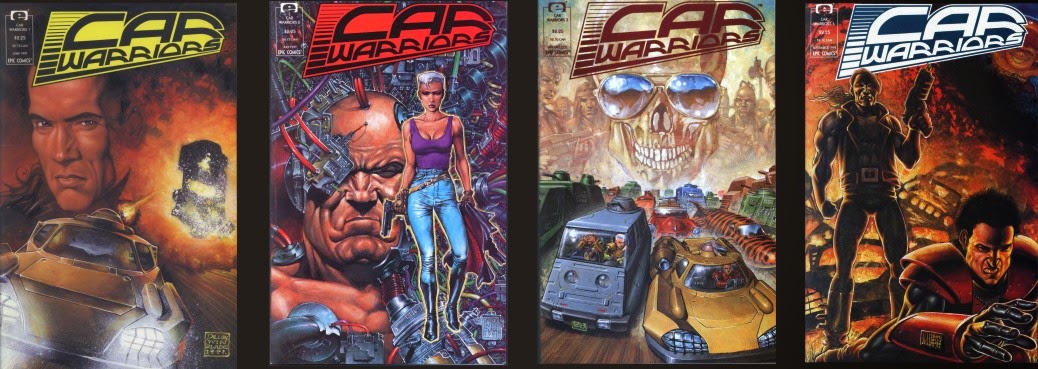Volume One
by Tim Truman
Dynamite Entertainment, 2006
Scripted and drawn by Tim Truman, the first issue of ‘Scout’ was published by the Indie publisher Eclipse Comics in September, 1985, and ran for 24 issues until October, 1987.
The eponymous Scout was an Apache Indian named Emanuel Santana (Truman is an avid fan of rock musician Carlos Santana). The series was set in the near future, i.e., ca. 1999, and the USA is in bad shape, beset with economic collapse, eco-disasters, widespread political corruption, and, in the cities, anarchy and lawlessness.
While Eclipse issued graphic novels compiling the 'Scout' series, those volumes are long out of print. In 2006 Dynamite Entertainment released the first 16 issues of 'Scout' in two trade paperback compilations; volume one compiled issues 1-7, and volume two, 8 – 15. The comics in these compilations have been recolored and ‘remastered’ (whatever that means.....?).
Volume 1 features an Introduction from John Ostrander, Truman's writer for the 'Grimjack' comic book series from the mid-80s. There also is a interview with Truman that serves as the book's Afterword; in the interview, Truman admits that he initially was reluctant to see his 'Scout' comics compiled and reprinted, because he was ambivalent about the quality of his draftsmanship back in those long-ago days.
Be that as it may be, I find the artwork in 'Scout' to be well done, and, as always, a relief from the 'line-drawing' aesthetic, designed to accommodate computer scanning and coloring, that dominates comic book artwork nowadays.
The color separations are not ideal - the book's original printing technology is of course nearly 30 years old- and leave the panels with a 'murky' look, but again, I'll take it over the artificial appearance of the color in so many of today's comic books.
I won't disclose any spoilers regarding the plot of these first issues of 'Scout', save to say that our hero embarks on a quasi-spiritual quest to identify and eliminate four monsters, beings drawn from ancient Apache mythology. These four monsters have taken on human guise, and all work cooperatively to take over the nation and use it for their own nefarious ends.
As an Apache, Scout is the prototypical loner, a man of few words. The narrative is suffused with a worshipful attitude towards Native American Wisdom, and at times this veers into Noble Savage territory, particularly when coupled with the author's (self-admittedly white liberal) left-wing take on the political and corporate establishments that have exploited and despoiled this near-future USA.
However, Truman provides enough sarcastic humor throughout the book to sufficiently lighten the mood, and prevent the arrival of a preachy or sententious atmosphere.
The first six issues of 'Scout' served as a complete story arc; issue 7, included in this volume, is a 'flashback' episode with very nice artwork from substitute artist Tom Yeates (Truman was on paternity leave). I confess to being unfamiliar with Yeates's work, but his illustrations for The Outlaw Prince series have received high praise.
Summing up, whether you're a fan of well-told and well-illustrated comics with a 'Mad Max' type of atmosphere, or whether you're a fan of Truman's graphic work, a copy of 'Scout: Volume One' is well worth getting.
[Volume Two complies issues 8 - 15; however, it's unclear of the remaining contents of the series - i.e., issues 16 - 24 - are going to be issued in a graphic novel from Dynamite.]
The color separations are not ideal - the book's original printing technology is of course nearly 30 years old- and leave the panels with a 'murky' look, but again, I'll take it over the artificial appearance of the color in so many of today's comic books.
I won't disclose any spoilers regarding the plot of these first issues of 'Scout', save to say that our hero embarks on a quasi-spiritual quest to identify and eliminate four monsters, beings drawn from ancient Apache mythology. These four monsters have taken on human guise, and all work cooperatively to take over the nation and use it for their own nefarious ends.
As an Apache, Scout is the prototypical loner, a man of few words. The narrative is suffused with a worshipful attitude towards Native American Wisdom, and at times this veers into Noble Savage territory, particularly when coupled with the author's (self-admittedly white liberal) left-wing take on the political and corporate establishments that have exploited and despoiled this near-future USA.
However, Truman provides enough sarcastic humor throughout the book to sufficiently lighten the mood, and prevent the arrival of a preachy or sententious atmosphere.
The first six issues of 'Scout' served as a complete story arc; issue 7, included in this volume, is a 'flashback' episode with very nice artwork from substitute artist Tom Yeates (Truman was on paternity leave). I confess to being unfamiliar with Yeates's work, but his illustrations for The Outlaw Prince series have received high praise.
Summing up, whether you're a fan of well-told and well-illustrated comics with a 'Mad Max' type of atmosphere, or whether you're a fan of Truman's graphic work, a copy of 'Scout: Volume One' is well worth getting.
[Volume Two complies issues 8 - 15; however, it's unclear of the remaining contents of the series - i.e., issues 16 - 24 - are going to be issued in a graphic novel from Dynamite.]



































































































